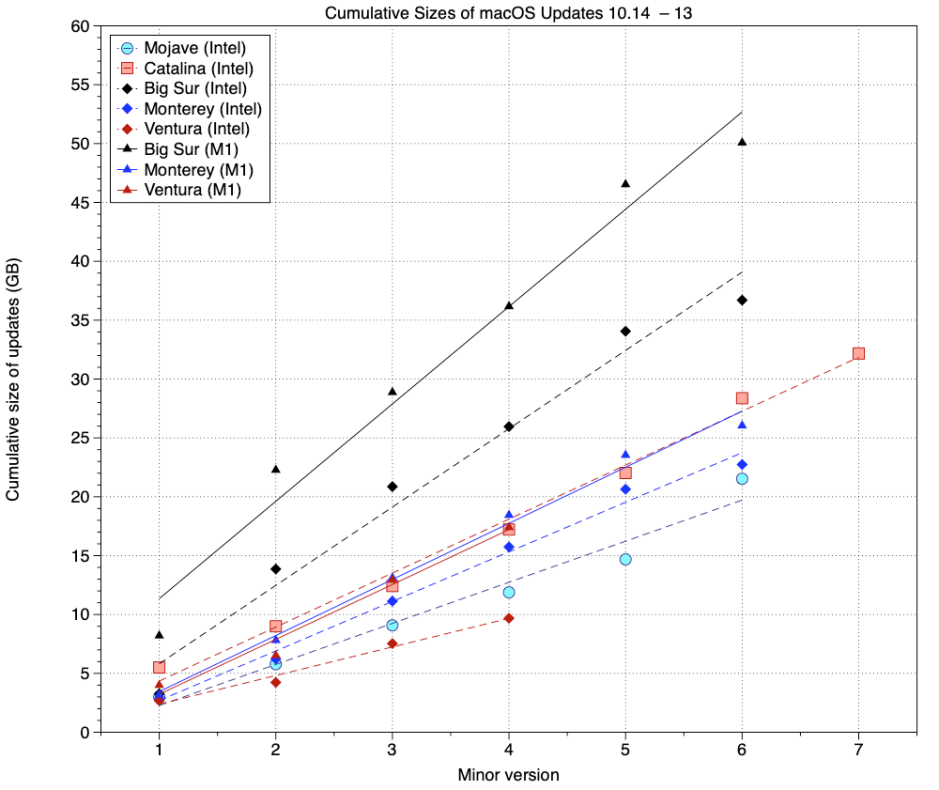It’s common knowledge that, since Apple introduced its new Signed System Volume (SSV) in Big Sur, macOS updates have been larger than ever. Now that Ventura has reached version 13.4 and is approaching the end of its period of full support, this article checks the numbers to see whether they support that widely held view.
To assess this, I’ve used the records that I make of the size of downloaded updates to two different types of Mac: an iMac Pro, with its Intel CPU and T2 chip, and a succession of M1 Macs. Those sizes are given in each article detailing the release of that macOS update in my collection, from macOS Mojave to Ventura. Cumulative sizes were obtained, such that the total given for 11.3 is the sum of sizes for 11.1, 11.2, 11.2.1, 11.2.2, 11.2.3 and 11.3.
Results
These are shown on the chart below, from Big Sur onwards split by architecture, with a line regressed onto each set of sizes.

By far the largest updates were those for Big Sur, shown here in black, with triangles and the solid line for M1, and diamonds and the broken line for Intel. By the time that Big Sur entered its first year of security-only maintenance, each Intel Mac had downloaded 37 GB of macOS updates, and each M1 Mac an astonishing 50 GB.
Mojave and Catalina, shown using light blue filled circles and pink filled squares respectively, and Intel-only, were considerably better than Big Sur. However, Monterey (blue symbols) and Ventura (red symbols) came close. Of the five major releases of macOS for Intel Macs, Ventura (red diamonds and broken line) is the smallest, reaching slightly less than 10 GB with the x.4 release. Although the matching line for M1 Macs (red triangles, solid line) is higher and steeper in gradient than that for Intel Macs, it’s almost identical to those for Catalina (Intel) and Monterey (M1).
These figures demonstrate that, far from being worse than its predecessors, macOS Ventura has so far brought smaller updates.
Reasons
There are several factors that could be responsible for Ventura’s updates being so relatively small.
Each macOS update is delivered with a complete set of firmware updates for all supported Intel Macs. Although individually these aren’t large, as they’re bundled with every update their sizes accumulate. Ventura supports only 7 Intel models without T2 chips, whereas Big Sur supports 25. Thus the overhead of providing firmware updates is reducing with each major release of macOS.
More significant is the marked reduction in the number of updates more recently. Not only were each of Big Sur’s updates large, but there were 12 of them by the release of 11.6. Monterey required only 10, and so far Ventura has 7, with just two more updates scheduled to take it to 13.6. That excludes the recent RSR, which I haven’t counted in its cumulative total as its security fixes were also rolled into 13.4. Clearly it’s one of Apple’s aspirations for RSRs that they can further reduce the total size required for macOS updates by eliminating at least some intermediate security updates.
Apple has also been steadily improving the engineering of macOS updates since the heady days of Big Sur. The minimum size of a Big Sur update was 2.3 GB for Intel and 3.3 GB for Apple silicon, which has reduced in Ventura to 0.5 GB and 1.9 GB respectively. On some older Intel Macs, these new more compact updates do take longer to prepare, but are normally far more rapid on Apple silicon Macs.
Big Sur seems to have marked the high tide for macOS update size. With improved engineering, falling overhead from firmware updates, and RSRs, macOS updates should be even lighter in their burden.
